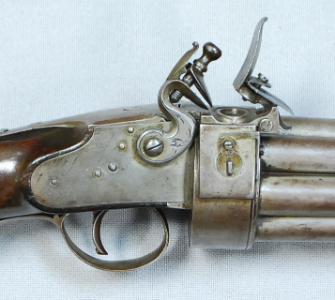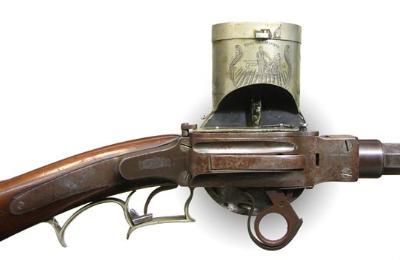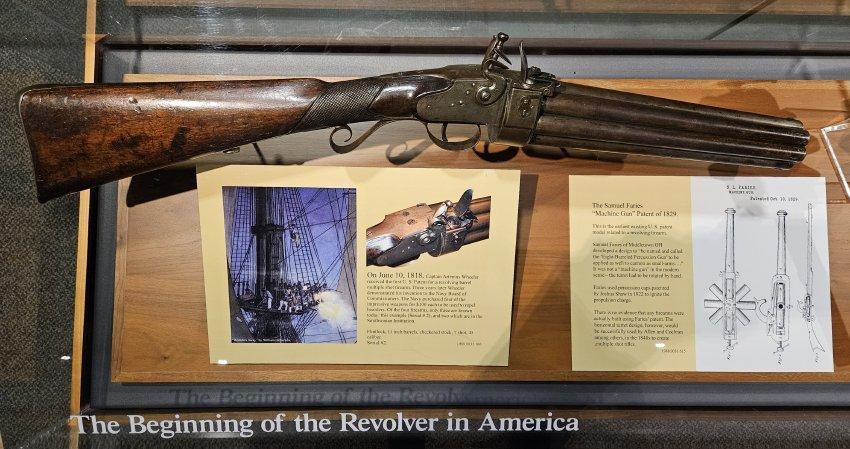Henry Stewart Collection
Over a fifty year period, Henry M. Stewart, Jr., VMI Class of 1935, assembled one of the world's great antique firearm collections.
Many of the pieces in the collection are one-of-a-kind or the only known surviving example of its type. Over 350 U. S. government, patent office models relating to firearms are also included in the fascinating collection.
Some fifty rare pieces illustrating the mid 19th-century search for a successful revolving cylinder firearm are on exhibit in the museum.
The total collection numbers over 800 pieces and is available to serious researchers by appointment. The museum has plans to place the entire collection on public exhibit. The collection includes the air rifle carried by Lewis and Clark during their 1803 Northwest Expedition; the Artemus Wheeler Revolving Carbine--one of four purchased by the US Navy in 1821; several cased Colt Patterson firearms; and a fully engraved Porter Rifle.
"...we showed them many curiosities and the air gun which they were much astonished at." - William Clark, August, 1804
Clock and gun maker Isaiah Lukens of Philadelphia, PA, provided Meriwether Lewis and William Clark one of his air rifles for their 1803-1806 expedition to explore the northwest. Unlike most rifles which used black powder, the air rifle used compressed air to shoot its .31 cal. bullet.
Unlike black powder rifles, an air rifle made little noise when fired. It did not make smoke and had very slight "kick." And, you didn't have to "keep your powder dry!"
The butt of the rifle is actually a metal canister designed with a needle valve to hold compressed air. The air was stored under pressure --between700 and 900 pounds per square inch! (A modern car tire carries a pressure of 35 pounds per square inch.) When the trigger is pulled, just the right amount of air is carried from the butt to the bullet chamber and the round leaves the barrel with a whish.
This is an air rifle butt reservoir screwed to the pump used to compress the air. The auger end (to the right) could be screwed into a tree. A few hundred strokes on the pump and you were ready to go hunting.
Although the rifle was used in hunting, its main purpose was to impress the Native Americans Lewis and Clark would meet. Upon returning home Lewis and Clark presented the history making air rifle back to Isaiah Lukens.
 Artemus Wheeler patented his new firearm in 1818. His invention was the first revolving firearm to receive government trials (1820), and the first accepted by the military. The Navy purchase two carbine and two musket versions in 1821 to use as boarding weapons.
Artemus Wheeler patented his new firearm in 1818. His invention was the first revolving firearm to receive government trials (1820), and the first accepted by the military. The Navy purchase two carbine and two musket versions in 1821 to use as boarding weapons.
The carbine shown here is a flint lock, automatic priming(a small amount of primer powder was scraped into the pan as the cylinder was revolved) .45 caliber.
 Among the most imaginative and unusual approaches to creating a multiple shot firearm is P. W. Porter's invention, patented in July of 1851. The rifle (left) was automatically loaded when the leaver was operated rotating the vertical cylinder (turret) under the silver magazine which housed bullet, powder and primer. All three ingredients were "loaded" into the vertical cylinder in the proper proportions.
Among the most imaginative and unusual approaches to creating a multiple shot firearm is P. W. Porter's invention, patented in July of 1851. The rifle (left) was automatically loaded when the leaver was operated rotating the vertical cylinder (turret) under the silver magazine which housed bullet, powder and primer. All three ingredients were "loaded" into the vertical cylinder in the proper proportions.
Porter gave up on the elaborate mechanism in his later models and relied on hand loading of the vertical cylinder. The example in the Stewart Collection is the only known complete and engraved model. Engraved on the side of the silver magazine setting atop the rifle is a scene depicting the advantage one would have using a Porter rifle (above). On the top of the magazine (right) Porter had engraved the U.S. Capital building in Washington. This is the only example with its magazine in existence.
.svg)
.png)


